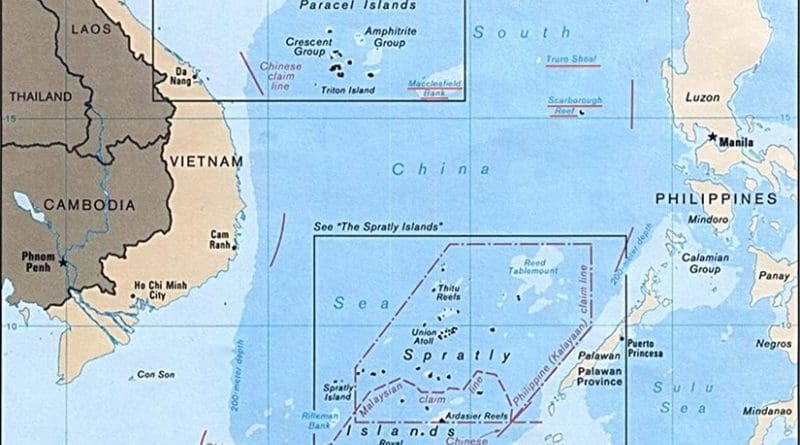Comparison Of Strategies Of China And US In South China Sea
Globalization has also played a vital role in integrating the world and economic dependence of countries for instance, in case of China and the US they are dependent upon each other in economic terms and avoid direct confrontation with each other. They have period of good and bad relations the distrust is major cause of conflict between the two parties. The high diplomatic visits in 1960s reduced the tension between Sino-US relations and marked beginning of new chapter of good relations but US is not ignorant about the role of China in global politics specially within in Asia-Pacific region.
This article focuses on Sino-US rivalry over South China Sea; the comparison of strategies of both and how they have developed overlapping interests in Asia-pacific region. Usually states have good or bad relations with each other, but in this case what is unique to note is that they (Sino-US relations) had phases of cordial and strained relations. As a consequence, they keep checks on each other power to safeguard and expand their area of influence in the world by using military, economic and political means.
South China Sea basically consists of a groups of islands. (“South China Sea? Some Fundamental Strategic Principles,” 2017) First, the Spratly Islands are (located 200 miles to southwest of Hong Kong) claimed by both China and Taiwan. Second, although the Parcels Islands are located in the northern part of the South China Sea and near from the coastlines of Vietnam and China (Hainan), however, these islands are claimed by China, Vietnam and Taiwan. On the other hand, China took control of Parcels in 1974, by using the means of force from South Vietnamese troops and it is one of the main reasons of conflict between China and Vietnam.
The Separately Islands (are located in the centre of the South China Sea. to the north of the island of Borneo [which comprises Brunei Darussalam and the east Malaysian States of Sarawak and Sabah], east of Viet Nam, and west of the Philippines and south of Hainan) are claimed in their entirety by China, Taiwan, and Vietnam, while some islands and other features are claimed by Malaysia and the Philippines. Brunei has established a maritime zone that overlaps a southern reef, but it has not made any formal claim. Therefore, the intense competition among states has become a main source of concern and even potential conflict as it consists of cluster of small islands that have distributed claims by almost all ASEAN states.
Chinese Strategies for South China Sea
In Deng’s view, China always pursued a policy of delay to respond to any foreign stimulus. As a result, it helps to accelerate the development and prosperity of China in term of utilizing economic means to the fullest. (Diplomat, 2017) South China Sea had been one of the most contested areas of world. Most of the states involved in this area claim certain areas, while rest declares their open claims on the other part in Asia –Pacific region. The policy of claims and counter claims is the main source of conflict. Despite many efforts of ASEAN and regional players, the South China region continues to be matter of contention and a major impediment in bringing peace and stability in the region.
The military agreements between US and Taiwan and US and Japan in Guam is another example that established military buildup against Chinese expansion in the region to secure an array of states from any potential Chinese attack. According to Andrew Erickson, China is also increasing its defense budget to secure its territory of East and South China seas and their airspace above this area. This implies that the reliance of states on traditional means or military continues to play an important role in providing security to states.
US Strategies for South China Sea
USA National Strategy for South China Sea consists of four main points. First deals with their official stance over South China Sea. Second one is about legality of the nine-dash line claim of China. Third one concerns with freedom of navigation in South China Sea and fourthly deals with supporting Philippines in their arbitration case against China. (Wuthnow, 2017) In 2010, the Obama administration declared what was then referred to as the “US pivot to Asia,” that consists of multi-faceted strategy of US policy in the Asia pacific region. It includes shift of 60% of the United States naval assets to the pacific region reversing a policy that had been exercised in Europe since the Second World War. The strategy was supposed to go beyond the military means.
According defensive realist, states try to maintain status quo and ensure their security instead of direct confrontation that would make them vulnerable and expose their weaknesses. (MORI, 2017) In case of Sino- US conflict, China pursues a policy of non- confrontation, but it is often considered to be an offence by others states in the region. In this article, Chinese defensive policies are taken as offensive by US and they try to limit their power in region and at global level. US on the other hand, pursues a policy of an offensive realist that curtails a rising power from emerging in terms of any compromise or tolerance to competition or sharing of the power as it would undermine their hegemony and their status of sole power in global politics.
About the author:
*Mehwish Akram holds masters degree in International Relations and currently doing M Phil in Political Science. Her areas of interest are Democracy, Political theory and Environmental politics.

